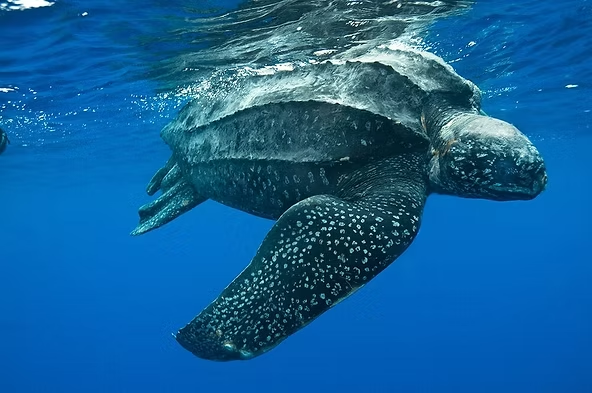Leatherback Turtle: The Deep-Diving Giant
Leatherback turtles are the world’s largest turtles, reaching up to seven feet long and over 2,000 pounds. They are the last surviving members of a turtle family dating back over 100 million years. Leatherback populations are declining rapidly in many areas, except for the Arctic and Antarctic oceans.
1. Turtle Shell
The leatherback’s inky-blue carapace is slightly pliable and rubbery, unlike the hard shells of other sea turtles. Key features include:
- Ridges along the shell create a hydrodynamic shape
- Can dive to 4,200 feet—the deepest of any turtle
- Can remain underwater for up to 85 minutes
2. Population Range
Leatherbacks have the widest distribution of any reptile, inhabiting both tropical and temperate waters worldwide:
- Pacific, Atlantic, and Indian Oceans, plus the Mediterranean Sea
- Range extends as far north as Canada and Norway
3. Coldwater Adaptations
Unlike other reptiles, leatherbacks can maintain warm body temperatures in cold waters due to:
- Large body size
- Specialized swimming activity and blood flow
- Thick layer of fat for insulation
4. Reproduction
Leatherbacks have the longest migrations among sea turtles, approximately 3,700 miles each way. Female reproductive behavior includes:
- Mating at sea and coming ashore to nest
- Digging a hole in sand, laying ~80 eggs, and covering the nest
- Returning to the sea, leaving disturbed sand to confuse predators
5. Behavior and Diet
Leatherbacks spend most of their life at sea and are powerful swimmers. Feeding traits include:
- Deep-diving capability to 4,000 feet, staying submerged for 80–85 minutes
- Diet consists mainly of soft-bodied prey like jellyfish and salps
- Sharp-edged jaws and backward-pointing spines in the throat help retain prey
6. Major Threats
Leatherbacks face numerous dangers, including:
- Bycatch in commercial fishing gear (longlines, gillnets), causing population decline
- Egg predation in multiple countries
- Ingestion of plastic debris that mimics jellyfish, leading to digestive blockage

